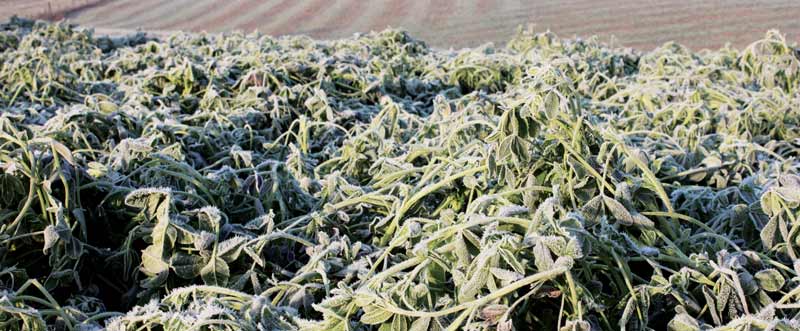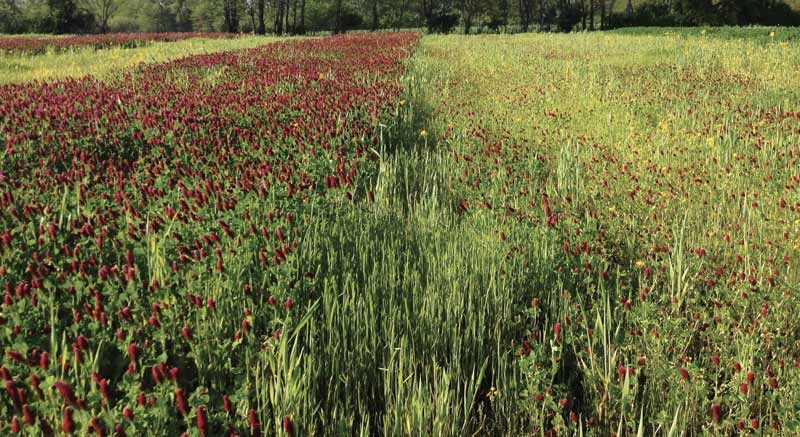Pictured Above: DEFINITE DIFFERENCE. A variety trial at the University of Illinois Ewing Demonstration Center shows clear differences in variety performance. Kentucky Pride crimson clover, on the left, was developed by the University of Kentucky for improved cold tolerance. On the right is Dixie crimson clover, a variety from the 1950s used for re-seeding pastures that hasn’t been improved since its introduction.
The steady rise of cover crop use and interest in recent years has plant breeders, geneticists, agronomists, cropping systems researchers, government agencies, universities and seed companies turning their attention to making the practice a success. Each treads one of the following paths to improving cover crop species and their use in a cropping system:
- Cover crop field trials assessing best practices and geographies for currently available varieties.
- Introducing varieties from other countries or from heritage lines.
- Breeding new germplasm lines and introducing new varieties.
- Using gene sequencing to advance positive traits.
Each method will deliver, or already has delivered, more functional and successful options for farmers looking to work cover crops into their farming systems. No matter their success or lack of it in the past, the advances made in understanding and developing cover crop varieties should have farmers looking into regionally adapted varieties each year to take advantage of the most current genetic advancements.
“It’s an exciting time. We’ve made a lot of headway with cover crop improvement in the last 10 years and in the next 10 years I wouldn’t be surprised to see double, to triple the improvements. There’s some low-hanging fruit out there,” says Jerry Hall, president of GO Seed (formerly Grassland Oregon), one of few private companies with an active cover crop breeding program.
Breeding: The Near Future
For the first time in decades, there is a concerted effort to advance cover crop genetics.
Steven Mirsky, USDA research ecologist, helped spearhead a nationwide effort that has become known as the Cover Crop Breeding Project (CCBP). Coordinated teams have raised $11.5 million of public funding in the last 5 years to develop and test regionally adapted cover crop germplasms — enough funding to carry on research for another 4 years. It is hoped they can achieve 5 new varieties for each species under development.
“We sought out material produced in cold climates to build a named variety that performs better…” – Heathcliffe Riday
Cooperators are spread throughout the United States from Western Oregon to New York and North Dakota to Texas. They include USDA-ARS plant material centers, universities and the Noble Research Institute — entities that usually work independently, Mirsky says. Together they manage multiple integrated cover crop projects including research station breeding, on-farm breeding, advanced line trials and growing seed supplies for new varieties.
Initial focus for CCBP has been on breeding better legumes, such as hairy vetch, winter pea and clovers. Work has since expanded to include brassicas and grasses. Advances in breeding in small grain crops, such as oats, and forage crops have also been tapped and evaluated to determine best varieties for cover crop use.
“The legumes coming out of our program are outperforming what’s commercially available. We’re looking forward to releasing varieties very soon,” Mirsky says.
Learn The Terms
Technical talk in plant breeding can get a bit confusing. What is the difference between germplasm and a cultivar? These terms are just different classifications that reflect levels of improvement. Let’s start at the broadest level:
Species: A group of like organisms that can interbreed.
Germplasm: The base genetics of a species from which new plant lines are developed. This would be the parent material to potentially many varieties, cultivars and hybrids.
Variety: A naturally occurring isolated group within a species bearing unique traits. Varieties will breed true, producing seed with generally the same characteristics as the parent plant.
Cultivar: A combination of “cultivate” and “variety,” a cultivar is a variety that has been carefully selected and bred for by plant breeders. Cultivars often will not breed true, creating offspring that do not resemble the parent plant.
Hybrid: The result of crossing two varieties. Like cultivars, hybrids will not breed true.
Advances have been made in winter hardiness of hairy vetch, crimson clover and winter peas. They’ve also selected for higher nitrogen (N) fixation, early growth and high biomass production. Varieties from these efforts should become available in the next 2-5 years.
“We take any advances and distribute them to an impressive number of sites across the nation. We compare improved material by regions to see where they will be the most successful,” Mirsky says.
In the next 2 years, they expect to release multiple varieties of hairy vetch targeting specific regions, including the Mid-Atlantic and North Central United States. The varieties have improved winter hardiness, growth rate and N production over the VNS seed that dominates the market for many cover crop species.
“Most hairy vetch seed is VNS and produced in Australia or Argentina. It has no winter hardiness,” says research geneticist Heathcliffe Riday, who is breeding new hairy vetch and crimson clover cover crop varieties for the Agriculture Research Service’s (ARS) U.S. Dairy Forage Research Center. “For our breeding program we sought out material produced in the upper Midwest and other cold climates to build a named variety that performs better.”
Riday also pulled from the U.S. Nicotiana Germplasm Collection for winter hardy hairy vetch germplasm from the Ukraine and Russia.
Disease resistant winter peas will be targeted to more southern states in the next 2 years. To follow will be crimson clover with earlier growth rates and in roughly 5 years soft seeded/shatter resistant hairy vetch. CCBP cooperators are beginning to look into higher allelopathic rye as well.
Private breeders are also making advances. GO Seed bred and released FIXatioN Balansa clover and Frosty Berseem clover from their programs and look forward to releasing a new Persian clover variety in 2021. FIXatioN Balansa clover is touted to produce 200 pounds per acre of N, be cold tolerant to -15F and quickly produce a substantial amount of root and forage. Frosty Berseem boasts of improved cold tolerance and productivity.
These improved varieties can make a huge difference in a range of climates. In a Mississippi State cover crop variety trial, FIXatioN Balansa clover made 186 pounds per acre of N available to crops when terminated April 1 as compared to the 124 and 53 pounds per acre of N produced by the other two varieties in the trial.
In an Idaho USDA cover crop study, FIXatioN had a 47% better winter survival rate than the other variety in the study along with a 22-inch height advantage at 50% bloom. It bloomed a full month later than the competing variety.
Winter pea breeding has the advantage of decades of ongoing robust genetic advancement for human consumption and for forage. Rebecca McGee, USDA-ARS research geneticist, is branching out from those programs to breed winter peas more suited for cover crops, though it’s no easy task.
“Winter peas used for cover crops are conceivably in the field for 10-11 months depending on the system and are hit with every environmental extreme you can imagine and vulnerable to every pest you can think of as well as all the diseases,” McGee says. As a result, her breeding programs focus on cold tolerance and resistance to diseases, insects and soil-borne and foliar pathogens. Additionally, she’s working to advance biomass production, N fixation and nutritive quality.
“If you’re not evaluating the majority of varieties available you can’t condemn a species for a region…” – Jerry Hall
McGee notes through field trials they’ve learned a lot about how different varieties perform in different regions which has helped guide the cross block decisions they make for adapted varieties.
“We have a tremendous pipeline full of material we can hope to release over the next 10 or so years. We’re in a state of constant improvement,” she says.
In the past 10 years, McGee and her collaborators have released one cultivar and one germplasm line suitable for cover cropping. In the coming year or two, though, she expects quite a few germplasm and cultivar releases. The cultivars will be regionally adapted and released as a group with cultivars intended for the inland Pacific northwest, northeast, southeast, the upper Midwest and Texas and Oklahoma.
Curated Collection
Cover crop seed companies play an important role in the improvement of cover crops. They’re invested in finding the best solutions for their customers. That includes identifying, sourcing and testing various cover crop varieties and species.
Breeding cover crops isn’t in the business model for Green Cover Seeds, for example, but they work to identify and bring to market cover crop varieties and species that provide growers with effective options.
“We have 130 different varieties of cover crop seeds. We’ve had many more over the years, but we no longer carry them because we’ve found something better. We’re always on the lookout for better genetics,” says Keith Berns, Green Cover Seeds co-owner. He notes they keep a diverse lineup as they serve producers throughout the country.
One quarry of his is a better sunnhemp variety. Most VNS sunnhemp is produced in India or South Africa and doesn’t adapt well to many U.S. regions. However, the USDA developed a variety known as Tropic Sun in Hawaii in the 1970s. It features lower alkaloids, making it safer for grazing and shows improved performance as compared to what’s currently on the market. While they can get the germplasm, they’ve run into difficulties trying to produce the seed. But it’s a problem they’re working to overcome.
The company ventured to a breeder in New Zealand to bring the Smart Radish variety to their customers. It features a ‘pull-down’ tap root with many branching roots that keeps more biomass in the ground instead of pushing up and out of the soil surface. It also brings more biomass for better ground cover and grazing possibilities, Berns says. Closer to home they licensed Baldy Spineless Safflower — useful for grazing and compaction relief — from Montana State University.
Building Data
A challenge to the improvements made in cover crop varieties are the blanket statements made about cover crop performance due to limited field trial data that includes variety comparisons. This is problematic as varietal performance can vary wildly within a species.
People cite research saying, ‘See, this species won’t work here,’ when in reality, the study only looked at one variety. “It’s my biggest pet peeve. If you’re not evaluating the majority of varieties available you can’t condemn a species for a region. You’re not doing justice to the plant breeders improving varieties,” Hall says. Or to those looking to use them.
Those breeding new cover crop varieties and conducting thorough research are working to generate more complete data sets for specific, proven recommendations to hopefully replace the generalizations, recommendations that can expand the geographies where different cover crop species thrive and uncover different uses within systems.
NRCS and university research on differences between different cover crop varieties is increasing.
“I’m very excited about the national NRCS cover crop variety trial that began several years back. Some of the locations have begun to release their data and there are tremendous differences between varieties,” Hall says. Reports are available from NRCS Plant Materials Centers in Aberdeen, Idaho, and Corvallis, Ore.
Hall notes the initial reports revealed some winter pea varieties easily winter killed despite their name while other varieties showed tremendous cold tolerance, for example. In addition, there were significant variations in seed size between different cereal rye varieties, allowing for lower seeding rates that would help curb cost.
“Varietal performance issues can be huge. Going forward we will hopefully stop glossing over the difference in varieties and research will fill in so varieties can fill potential niches,” Hall says.
The CCBP also tests diverse cover crop genetics at over a dozen sites nationwide. Combined with NRCS cover crop variety trial, the data provides an unprecedented analysis of regional variety trial performance. Data generated is being worked into cover crop selection tools, which is part of the CCBP mission.
“We’re actively involved in cover crop councils and other organizations helping to produce supporting materials, information and tools for implementing cover crops. This includes actively developing regionally adapted information on the performance of different varieties,” Mirsky says.
Challenges To Advancement
There are certainly hurdles to overcome in breeding, sourcing and selling improved cover crop varieties. Seed production is one. McGee notes traits that make a good cover crop don’t always line up with easy seed production. A late-maturing clover may produce more biomass, but may not have enough time to produce viable seed. Successful cover crop varieties must meet both needs and it can be a fine line to walk.

COLD EDGE. Frosty Berseem clover was bred for cold tolerance. Small plants peek through the snow at a GO Seed production field in St. Paul Oregon. The crop went on to produce a full seed crop. Larger Frosty Berseem plants were hit with a heavy frost that would have killed other Berseem clover varieties. It fully recovered.
Private investment in breeding cover crop varieties can be risky business, Berns says. The programs are costly and little to no protection exists to keep farmers from selling seed to each other instead of going back to the source.
The advantages of going through a seed company such as Green Cover Seeds, Berns says, is that they ensure seed quality, screening for weeds and ensuring good germination rates. Seed companies such as GO Seed will also likely take some profits and reinvest in their breeding programs for even more advanced genetics down the line.
Mixes present a complicated knot to unwind. Additional scrutiny must be placed on how certain traits are impacted when certain varieties are grown together in a mix.
For instance, some brassica varieties are touted for control of various nematodes, causing the nematodes to become active when their target crop isn’t growing. However, if those brassicas are grown in a mix and there’s a host plant also in the mix, this could serve to increase nematode populations instead of controlling them. All are factors that must be studied.
Genetic Sequence Guided Breeding
A positive for cover crop development is the use of genome sequencing. The pea genome has already been sequenced and McGee hopes to resequence several additional breeding lines and cultivars with a focus on cover crop traits.
CCBP researchers are currently sequencing the hairy vetch genome, which will guide breeding against hard seeds that cause hairy vetch to come back in subsequent crops. Sequencing is also being used in work to reduce hairy vetch seed shatter which will help increase seed availability for cover crop usage.
While exciting advancements are being made, more are on the way. Creating a new variety can take up to 10 years and most of these projects are just at the 5-year mark.
Thanks to little advancement since cover crops fell out of use in the ’70s, though, breeding projects are moving forward more quickly as there is plenty of ground to cover.
Those working to add cover crops in their cropping systems would be well-served to follow with close attention to the work being conducted on cover crop varieties in their regions. Just like a corn hybrid or wheat variety, making the right choice can make all the difference in the world.
For more information on the Cover Crop Breeding Project, visit www.covercropbreeding.com.








Post a comment
Report Abusive Comment